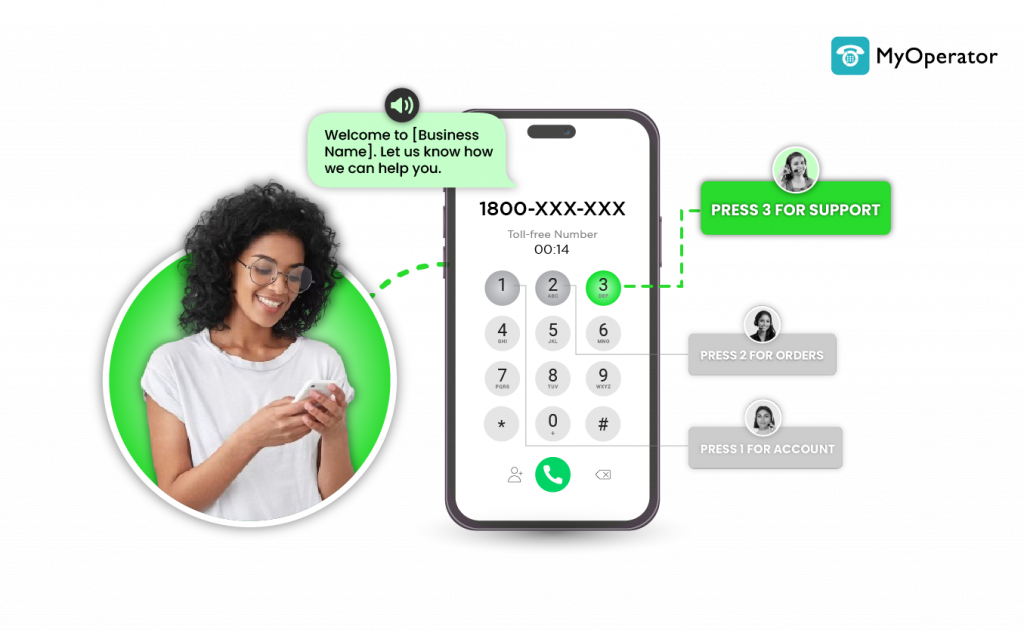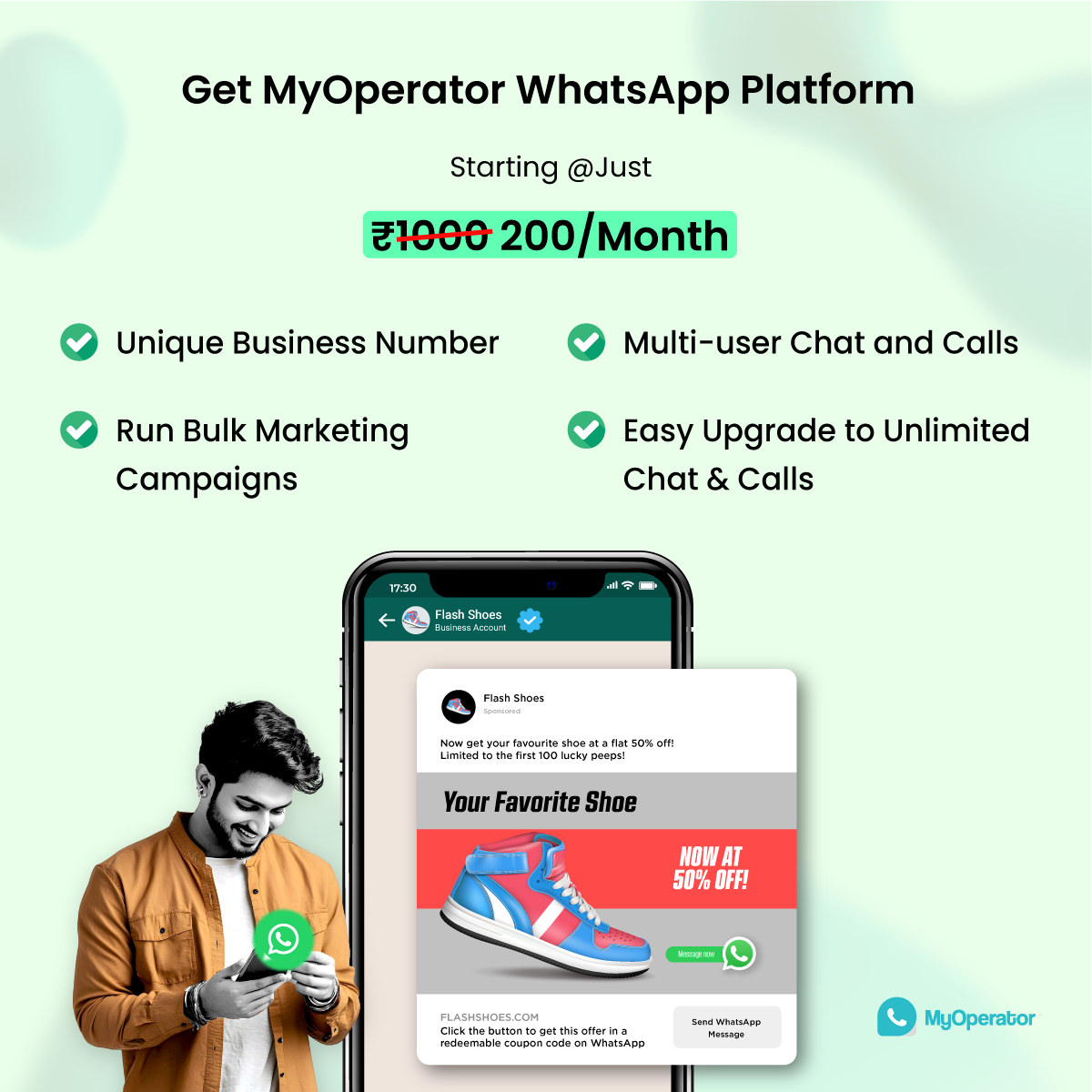IVR System is becoming a necessity for small and big businesses alike, and in this blog, we will talk about the IVR system setup and its various technical aspects i.e. how to set up a customized full-fledged IVR system from scratch for business.
We will cover the aspects of how this setup will be working as a complementary full-time business attendant and dealing with its various customizations (various nodes, multi-levels/ multiple IVR, designing call flow, IVR for OBD, etc) and some important use cases for comprehensive IVR usage as per the requirement.
Also, we would cover the benefits and accountability of IVR systems when in use.
What is the IVR System?
Interactive Voice Response aka IVR is an automatic telephony solution that serves the callers, gathers their information which has been given by them in the IVR keypad menu and then routes their calls to the concerned recipient.
Suggested Resource: What Is IVR
Types of IVR
There are 3 types of IVR Services :
- Default IVR
- Location-Based IVR
- Contact Based IVR
Now, here we will briefly discuss IVR usage type and significant applicability:
- Default IVR: This is used when default audio IVR needs to be played on a call that is received on the virtual/toll-free number. For example, “Welcome to MyOperator, India’s First Call Management System” – This is default IVR if you call on MyOperator’s toll-free number.
- Location-Based IVR: This is used for setting up custom call routing depending upon the location of the caller. If we want to connect the caller with the agent in the same city/ state, then location-based IVR can be used. Location-based IVR is mostly used by companies having multiple branches in various locations and needs location-based routing.
- Contact Based IVR: This is used for having custom IVR for the different contacts saved up in your customer panel. This type of IVR offers different types of menu to different types of callers , it gives the flexibility to set up custom IVR to custom callers which are saved in our addressbook panel . For example : When a patient calls up the hospital toll free number then IVR offers options “ press 1 for setting up the appointment ,2 for report status “ , when a doctor calls up “ press 1 for patients records , press 2 for patients list“
Suggested Resource: Comprehensive Guide For IVR Design.
Setting up an IVR system
Call Flow Design in IVR
Call flow design is an important aspect of adopting an IVR system, the call flow designing part helps us to distribute and draw connections between the welcome greeting, music, and audio played, agents and customers.
Call flow design has the following options :
- Welcome music
- Setting up of IVR menu
- Setting up departments and extensions
- Adding timing (active hours and days)
- Preview call design
Suggested Resource: Complete Step-Step Procedure For Call Flow Design
Now, we will discuss in brief the various steps of call flow design and its significance. Let’s start:
- Welcome Music / Greetings: Here, the customer listens to the brand tone or brand audio during the call connection which can be used to establish a brand image in the customers mind using offers, brand stories, and brand jingles. The music would keep the customers interested as well as informing them about the brand. A small and snappy tone works best to pass on the business message.
- Setting up the IVR Menu: Now, here comes the most important part of call flow design which can make or break your IVR system efficiency and customer experience. IVR menu lets the customers press the keys and route their call to the concerned department.
- Setting up departments and extensions: In the IVR menu, the caller is offered the option to press the desired prompt button . for the various options in the main menu. For example: “ press 1 for services, press 2 for complaint, press 3 for others “. The complete setting up the buttons and connecting them with their respective audio recording which will be played is under the setting up of the IVR menu.
- Adding timings (hours and days): The addition of days and timings is necessary so that calls can be routed to right IVR options when agents are unavailable, ensuring 24/7 support. During non-business hours and off-days, the incoming calls can be redirected to a voicemail or callback request can be generated for the same. Thus serving the callers in a more effective and informed manner.
- Preview Call Design: Have a final look over the call flow designed for the IVR system, to ensure the audio and prompts come up at the right time and right points in the network for the overall effectiveness of the system.
Types Of IVR (In terms of levels)
- Multi-Level IVR: Multi-Level IVR can be defined as an IVR with a main menu and then each menu item having a sub-menu as summarized by this chart:

As you can see from the above chart, in multi-level IVR, you can place sub-menu for every IVR menu item. In the above example, if the caller chooses the “sales” option, s/he is presented with the option to “track orders,” ask “billing inquiries or “file product complaint.” Also, support menu-item offers different sub-menu, making your IVR multi-level and giving your customers easy resolution to their queries.
- Single Level IVR Single-level IVR can be defined as an IVR with a very straightforward main menu and from there the customer selects one of them. Unlike multi-level IVR it has no further options embedded.

This type of IVR is used by organizations that have a very simple nomenclature of services being provided and thus doesn’t require much effort from the IVR to solve and get to the core of the customer’s query.
How can IVR help my business stand out from the crowd?
Customer Service by IVR ;
We live in a competitive era that has seen an inflow of similar business models and disruptions like never before. That means many of the businesses offer the same services/products and the sales are always revolving around a solution to the pain point which is addressed by one and all.
The differentiating keypoint can be our customer-centric approach. For this along with all the other factors, IVR can be an essential service point for customer service.
Any delay in implementing the best possible solutions for your customers can be catastrophic. So, have an edge over the competition, try to resolve their issues, answer their queries promptly and with their complete satisfaction. That can be the differentiating key point of your business.
Amidst stiff competition, top-notch and timely customer service can be a key differentiating factor. An IVR service for your business can help you deliver 24/7 customer service, win the trust and loyalty from your customers, and also get word-of-mouth marketing. While IVR services have been around for years, not all businesses use them and that’s where you can take the leap for the next chapter of your business growth.
Stats that prove the IVR usage viability in today’s age as well :
- 83% of the customers would avoid a company after having a poor IVR experience.
- Interactive Voice Response Market worth 5.54 Billion USD by 2023.
- IVR is cost-effective: 7 times cheaper than talking to a Live Agent.
Caution: Things to take care of while implementing IVR
“A poor IVR can be damaging to customer relationships, but one that is quick and easy to navigate is a comfort and an asset in those relationships. IVRs’ effect on CX is a result of its design and use, not its purpose.” – Mckinsey Report
While implementing IVR for your business, you need to take special care of the following aspects:
- A one-size-fits-all mentality
- Confusing navigation and terminology
- Lack of timely updates
- Not measuring customer satisfaction with the IVR system
A one-size-fits-all mentality: Every business is different and so is the requirement of the IVR menu. So, while implementing the IVR system, make sure that it speaks the language of your customers and offers solutions to moist sought after questions of your customers.
Confusing navigation and terminology: The IVR navigation should be a breeze for the users so that they can easily surf through the IVR menu, click on the required prompt button and get the issue resolved without getting too much involved in the nitty-gritty of the terms. The terms used in your IVR menu should be simple, that your customers can understand.
Lack of Timely Updates: The part of the IVR menu which provides information about an outdated/ discontinued product or service may not seem a sort of blunder but it is these small details that put off the customers. So, for better customer experience, you need to make sure that your IVR menu is up to date and provides information about your latest offers, products, and services.
Not measuring customer satisfaction with the IVR system: As said: “If you can’t measure it, you can’t improve it.” In the context of IVR System, while quantitative call metrics such as call containment rate (percentage of calls completed within the IVR) call abandonment rate, et cetera, are frequently measured but qualitative measures such as customer experience and their hold time, satisfaction level after the call completion are often ignored. Be assured that both quantitative, as well as qualitative measures, are vital to measuring overall customer satisfaction with your IVR.
If both quantitative and qualitative metrics are improved, the efficiency of agents and churn rate of customers, both of them can be optimized
Conclusion :
Thus, we can conclude that an IVR system adoption is not enough for a successful contact touchpoint, you need to carefully design the call flow, structure the customer needs in the IVR menu, equip the agents with right tools, and above all measure the customer experience using the various metrics of the customer journey as well as the RoI of your IVR System.
So far, we have checked broader aspects of an IVR system, including its types, benefits, and best ways to IVR implementation to suit your business needs. We have also discussed that an effective IVR system can help your business grow by making a long-lasting brand image, contributing to increased customer retention, and most importantly, customer satisfaction.
Hope this article will help you reap the benefits of the IVR system with improved efficiency of your support teams and better customer experience.







